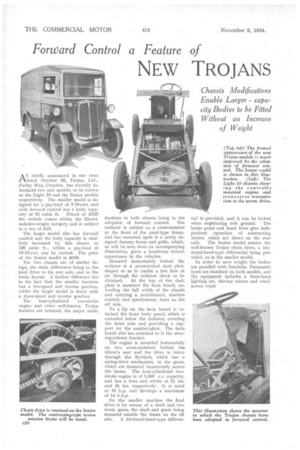Forward Control a Feature of
Page 80

If you've noticed an error in this article please click here to report it so we can fix it.
NEW TROJANS
AS briefly announced in our issue dated October 26, Trojan, Ltd., Purley Way, Croydon, has recently introduced two new models, to be known as the Light 10 and the Senior models respectively. The smaller model is designed for a pay-load of 7-10-cwt, and with forward control has a body capa
city of 91 cubic ft. Priced at £155 the vehicle comes within the 12.cwt. unladen-weight category and is subject to a tax of £10.
The larger model also has forward control and the body capacity is similarly increased by this means to 120 cubic ft., whilst a pay-load of 10-12-cwt. can be carried. The price of the Senior model is £165.
The two chassis are of similar design, the main differences being in the final drive to the rear axle, and in the brake layout. A further difference lies in the fact that the smaller machine has a two-speed and reverse gearbox, whilst the larger model is fitted with a three-speed and reverse gearbox.
The four-cylinciered two-stroke engine and other well-known Trojan features are retained, the major modi-. fications to both chassis being in the adoption of forward control. The radiator is carried c..:a a cross-member at the front of the punt-type frame, and has mounted upon it a newly designed dummy frame and grille, which, as will be seen from an accompanying illustration, gives a handsome frontal appearance to the vehicles.
Mounted immediately behind the radiator is a pressed-steel dash plate shaped so as to enable a free flow of air through the radiator block to be obtained. At the top of the dash plate is mounted the facia board, extending the full width of the chassis and carrying a switchboard, mixture control, and speedometer, inset on the off side.
To a lip on the facia board is attached the front body panel, which is extended below the radiator, covering the front axle and providing a support for the number-plate. The facia board also has attached to it the steering-column bracket.
The engine is mounted horizontally on two cross-members behind the driver's seat and the drive is taken through the flywheel, which has a spring-drive mechanism, to the gears, which are mounted transversely across the' frame. The four-cylindered twostroke engine is of 1,4SS c.c. capacity, and has a bore and stroke of 2i ins. and 41 ins. respectively. It is rated at 10 h.p. and develops a maximum of 14 b.h.p.
. On the smaller machine the final drive is by means of a shaft and two worm gears, the shaft and gears being mounted outside the frame on the off
side. A frictional-band-type differen
tial is provided, and it can be locked when negotiating soft ground. The brake pedal and hand lever give independent operation of contracting brakes, which act direct on the rear axle. The Senior model retains the well-known Trojan chain drive, a frictional-band-type differential being provided, as in the smaller model.
In order to save weight the bodies are panelled with Sundeala. Pneumatic tyres are standard on both models, and the equipment includes a three-lamp lighting set, driving mirror and windscreen wiper
























































































































